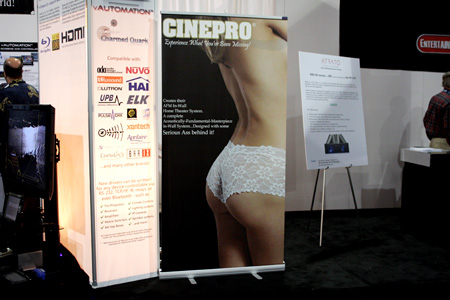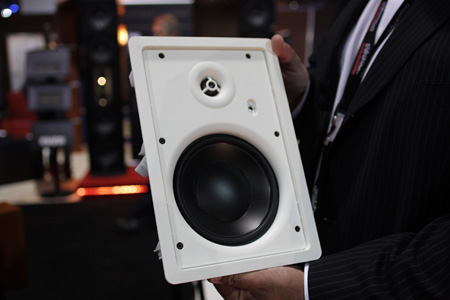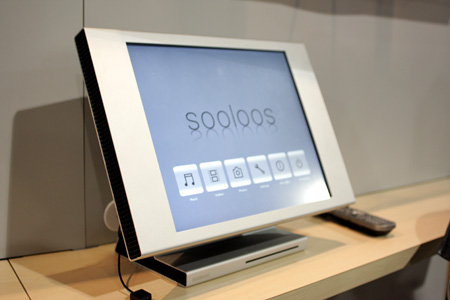| Doug Schneider Sunday, September 7
Everyone knows the old saying "sex sells," but
does it sell consumer electronics? I was thinking about this as I was looking at some of
the displays and seeing ones that were quite obvious in their use of sexual images. In
particular, I took note of four companies using sexual images in their displays, and as my
old marketing prof' would have have had us do, I critiqued the displays on their
effectiveness. In my opinion, here's how successful the companies' approaches are
in promoting their products.

The most appealing display was from KEF and inspired by the
company's print ads, which show the Muon loudspeaker with a nude woman close by. In the
banner above, the woman is on a chair facing the other way. In the floor display, there
was a clever touch, with the image of that same woman painted on a clear panel and
placed alongside one speaker. The image looked so real that some people, myself
included, actually mistook it for an actual person. In talking to the woman at KEF who
created this display, I learned that the female pictured is a European model who is a
friend of Ross Lovegrove, the designer who conceived of the Muon's appearance and the
overall look of the ads.
In my opinion, the concept works because the inclusion of
the woman can be considered relevant to the product being sold. KEF has described the
Muon's shape as "womanly" -- probably based on the speaker's height, curves and
elegant shape -- so having a woman situated nearby more or less enhances that image. In
fact, without the woman, the speaker might be mistaken for a large stainless-steel
hourglass. The model adds a positive, feminine touch. In terms of using sex to sell, I
believe that this tasteful, elegant KEF display works.

In contrast to KEF's display was Earthquake's attempt to
market the Supernova MKV subwoofer using a "...More Bang for Your
Buck" slogan over the top of a lingerie-clad young woman perched on the sub.
Admittedly, the scantily clad woman caught my eye, but do the image and the slogan create
a positive image for the product? Not to me.
Whereas KEF's images of a woman make the Muon more
appealing, which might turn into increased sales, I'm not sure anyone is going to buy a
Supernova MKV based on how the woman is portrayed here. It's cheap and sleazy. While KEF's
approach is tasteful, Earthquake's is tasteless.

Much the same can be said about Powerbridge's "Get
Turned On" campaign. Sure, the picture of the woman bent over might make some
people look (on the other hand, unlike the Earthquake shot, I actually missed this one the
many times I walked by), but, in the end, is it really going to entice someone to
buy the products? Maybe if I were a 19-year-old frat boy it would. However, I don't think
19-year-old frat boys are interested in high-priced custom-installed electronics -- that's
the domain of middle-aged men, who, just like me, are likely to consider the attempt to
sell juvenile. Like Earthquake's attempt, Powerbridge's also misfires.

Finally, there's Cinepro's "serious ass behind
it" campaign. I'll be honest -- it confused me. I didn't know what it means. But,
thinking I'm a little dumb, I asked others and they didn't understand it either.
Perhaps it's a phrase that we're not familiar with, or maybe it's the result of an
over-exuberant marketer with a picture of a woman's backside looking for a reason -- any
reason -- just to use it. I pick the latter. If you're going to use sex and a
slogan, at least make sure the slogan means something -- anything.
If companies want to try the "sex sells"
approach, perhaps for CEDIA 2009, they're best off following KEF's example and certainly
not the other three.
Saturday, September 6
In-wall speakers are the forgotten children of the audio
industry. Designers usually don't talk about them, and much of the audiophile press treats
them as if they don't exist. They're just not something you see written about much -- at
least not in the way other kinds of products are.
That's too bad because the in-wall segment of the speaker
market is one of the largest in terms of growth. As homeowners become more and more
décor-conscious, they're often demanding that their speakers still sound good but not be
seen. In-wall speakers fill that need.
As a result, more companies are taking them far more
seriously and they are coming into their own with some rather creative designs coming from
some of the best minds in audio. As these designs continue to progress, the audiophile
press will have to take more notice, and that includes us at the SoundStage! Network.
So today I spent my time looking at in-wall speakers and
tried to find some with audiophile pedigrees. Here's what I found, along with a few
remarks about what I think makes them distinct:

Dynaudio showed the new IW 17 featuring the company's
well-known drivers and expert engineering, which is evidenced when you look around the back.
If you like Dynaudio sound and want your speakers up off the floor and out of the way,
these will be a good way to go.

Definitive Technology also makes its own drivers for the Di
(Disappearing In-wall) series, but the neat feature of these speakers is the size of the
hole you have to cut in the wall. If you look
around back, you'll see that the speakers require a much smaller hole than most do --
just enough to accommodate the baskets of the drivers. For the front, Definitive supplies
a large, flat flange that neatly covers up the hole. The result is an easier installation
because there should be no drywall repair.

Andrew Jones (above) is best known as the designer behind
TAD, the super-high-end speaker brand. TAD is actually owned by Pioneer and, therefore,
when Pioneer set out to create a new series of high-performance in-wall speakers, Andrew
was put in charge. The claim to fame for this series is the Concentric
Transducer Technology (CTT) that's also used in Pioneer's and TAD's traditional
speakers CTT puts the tweeter in the middle of the mid-woofer, resulting in even
dispersion and the same tonal characteristics regardless of the listening angle.
Therefore, finding a suitable place to mount these speakers should be easier than with
conventional multi-driver arrays.

Totem Acoustics has a new speaker line called Tribe. As you
can see from the picture above, it's a quite ambitious undertaking. On the left is an
in-wall speaker; on the right is an in-ceiling speaker. The in-ceiling speaker was of
particular interest to me because Totem, as well as many other companies, seems to be
putting quite a bit of focus on speakers that are to be mounted above. The company knows
that some consumers don't just want to free up floor space but wall space, too.

Finally, there's Paradigm, which had the challenge of
creating a surround speaker that included the company's Adaptive Dipole (ADP) technology.
Paradigm engineers managed to do it with models for the Studio and Signature series.
What you can see in the picture above is a tweeter peaking
out from behind a metal plate. What's not so apparent are the two midrange drivers that
are above and below the tweeter -- they're each about 4" high and 1" wide. When
you look at this shot of the entire
speaker, you'll see that each speaker has two tweeters, four midranges and a woofer.
Obviously, it's quite a complex design, and proof of the lengths companies are going to in
order to make audiophile-grade products that are lifestyle friendly. The SoundStage!
Network will attack this segment of the market more aggressively in the near future.
Friday, September 5
Yesterday I promise to find some cutting-edge,
next-generation, brand-new products. I didn’t find them, but I did find two products
that were pretty darned cool.
The first was the new ZX1M 40" flat-panel LCD display
in the Sony booth.

The neat thing about this display is how thin it is. I
didn’t measure, but someone said it was 9mm, and I believe it. Marc Mickelson held up
a pen for reference and the display
was about as thick as that.
At first I thought that the OLED (organic light-emitting
diode) technology might have something to do with how thin this display is. It didn’t
-- Sony was showing the same puny 11" OLED displays that were here last year. Rather,
it has to do with edge lighting the panel, rather than back lighting it, as is is usually
done.
Next, I’ll move on to music servers, which I believe
are The Next Big Thing. However, despite the fact that the world is moving that way, the
standalone music server hasn’t exactly taken over the planet yet. In fact, few people
have them, and I consider the ones who haven’t bought some kind of dedicated solution
to be smart -- at least for the most part. Quite simply, most of what’s out there in
terms of music-serving solutions pale in comparison to what can be created using MacBook
or a Windows-based laptop and some inexpensive software.
Enter Sooloos.

The thing that puts the Sooloos system ahead of the pack isn’t
just that the company has created a well-thought-out system that isolates the control
aspect of the system from the playback and storage sections (there are currently five
control systems, two playback systems, and three storage devices to choose from).
It’s that, at least at a glance, it seems to to better than what you can put together
using a computer. The styling is superb; the user interface seems spectacularly powerful;
and, from what others have told me, the sound quality is fantastic, particularly if you
hook up to it an external DAC. To see it is to want to use it. And once you use it, you
will want to own it -- or, in my case, at least review it.
As the music-server market continues to grow, other great
products are sure to come along. For now at least, the Sooloos system seems to be the one
to beat.
Thursday, September 4
I was disappointed by what I saw in the first
few hours of CEDIA Expo 2008. Basically, the same group of companies with the same booths
showed the same kinds of products that were here in 2007. I turned to Marc Mickelson and
said, "There's nothing really new." After a few hours, though, certain trends
started to emerge, and if I could sum up the best products at CEDIA Expo 2008 with three
words, they would be: convergence, convenience and quality.
Case in point: our visit to the
Paradigm/Anthem display, where the Canadian company had an audio/video demonstration to
showcase the new Signature in-wall speakers and subs. Obviously, the company wanted to
show off the new products. However, the point of the demonstration was to show that you
could have a single setup that played everything from two-channel music to multichannel
music and movies (convergence); that you could do it using in-wall speakers (convenience);
and, providing the speakers are good enough, you could achieve a first-rate presentation
in all areas (quality). The demo began with a two-channel music cut by the Wailin' Jennys
and finished off with a six-minute segment from The Dark Knight.

Paradigm wasn't the only company to show such
products. Boston Acoustics, Infinity, JBL, Revel, Monitor Audio and many others were
showing new products that delivered CCQ. Still, I know something new is out
there, and tomorrow I intend to find it. [www.paradigm.com]
|

